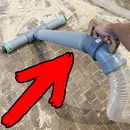Introduction: Zombie Bat With Interchangeable Heads
Having trouble with Zombies? Build yourself this barbarous zombie bat with six lethal interchangeable heads! All this with basic tools and without a lathe!
Let's be honest, the walking dead are fun, but only as long as you have the right tools to battle them. A regular baseball bat does the job, but truth be told it gets boring. Routine skull smashing from day to day..... Who wants to do that, right?
That´s why you need a bat with interchangeable heads! On Monday you might feel like going out shattering some Zombie scalps like a Viking with a double axe and on Wednesday you might be in the mood of using medieval mace to get the work done. On the Sundays, the atmosphere could be ideal for some sword work! You will never know! And the best thing is that if the weapon´s head breaks (which they will), you can easily craft a new one with ease.
This project has been on my mind for a long time. I have always wanted to build myself (for no specific reason) mace on a chain and now I finally have an excuse to do just that. AMC’s The Walking Dead is launching its new season and at the same time is partnering up with Instructables. The result is Survival Ready Contest and my savage zombie killer weapon is a part of it.
I used a minimal amount of tools for this build and most importantly no lathe! As post-apocalyptic world most likely does not have electricity, variety of hand tools are needed. Or you could just start preparing ahead like me and use your power tools!
Let us get started!
Step 1: Materials and Tools
Of course, you will need some lumber to make the bat. The harder the better! Zombie skulls are hard and you need something that is equally hard or better yet, harder! I recommend hardwoods like oak. It could be anything - firewood, a thick branch or milled lumber. I used laminated spruce timber measuring 12X12 cm ( 4.7X4.7 inches). I do have to say that my bat turned out pretty heavy so you could definitely get away with smaller sized timber.
The first part is making the handle or the body of the bat and for that you will need:
- Lumber
- Coupler nut (I recommend at least M10)
- Epoxy glue
I will have the materials list for each specific head in its step as well as tools needed for it.
Tools for handle:
- For shaping: hand plane, spokeshave, rasp, files and sandpaper ( or angle grinder with sanding disc)
- Manual drill (drill press) with spade/forstner bits
- Circular saw (to make the carving process go faster)
Of course power tools make it much easier but I have also added manual tools to the list.
Step 2: The Handle
Making the handle is the least fun and the most time consuming. But as it will be the heart of the weapon, I suggest you take your time with it. I messed up my first one by rushing too much.
Cut your lumber to length (around 40 cm /15 inches in my case) and start my marking the centres on both sides and drawing circles with a compass. This is important because you will later refer to these markings when carving the wood.
Cut off the corners with a circular saw, if you have one. From an octagon you need to remove fair bit less material than from a square.
Important: Drill the hole for coupler nut now, as the thing is much more stable (easier to hold) right now. I did it under a drill press. Make sure you have a snug fit - do tests if you need!
Then just start carving. Use different carving tools or do it with an angle grinder like I did. 40 grit sandpaper removes material quite easily. Do it outside if you can!
It is also a good idea to glue in the coupler nut in now. Use a hacksaw, a file or an angle grinder to rough up the outside surface of the nut to get more glue surface. Let it set for at least a couple of days (you want the glue to be fully cured).
Step 3: The Regular Head
Materials: lumber, hex bolt that matches with your coupler nut, a wooden dowel that has the same diameter as the head of your hex bolt.
Tools: Something to drill holes with, chisel and a hammer, shaping tool ( disc sander or angle grinder or rasp etc.)
I do have to apologise for the not so good pictures. The process is really simple but if you have any questions feel free to ask!
First, I cut your lumber to correct length. Used miter saw for this. Hand saw works as well, but be sure to get the cutline really straight. Then I drilled the bigger hole halfway through the wood. Measured it so that when pounding in the hex bolt, the threads stick out about an 2 cm/1 inch (or how long thr coupler nut is - the longer the better) out from the other side. In my case, the hole diameters were 20 cm for the bigger one and 12 for the smaller one. The aim is to get a snug fit. Pounded in the nut and glued a dowel to hide the hole on the top.
Screwed the head on the handle and marked the circumference. I took it off again and knocked the excess material off with a chisel and a hammer. Shaped the head with different sanders . You have your regular head for the bat in case you still want to play baseball during zombie apocalypse.
Pretty much all the other bat heads are based on this design so I am not going to describe making this again in the following steps.
Step 4: The Mace on a Chain Head
Materials:
- Lumber
- Lag bolts
- Chain
- Hex bolt
Tools: Angle grinder with cutting/grinding discs, Welding machine
So the head part started off like the regular one, but just a little bit shorter. The aim was that the head of the hex bolt would stick out so that a chain could be welded to it.
Of course, the important part is the spiked ball. I made mine back in 2005 as a gift to my little brother. As it got really no use I decided to give it a "new life". I made it out of a piece of firewood by simply sanding it to a round shape with an angle grinder. I screwed in a big lag bolt to which I welded the other end of the chain. At this point, it was done but it missed its lethal element. To fix this I drilled a dozen holes and screwed half way in more lag bolts. Then I chopped the bolt heads off and ground a sharp point with a belt sander.
It was done!
And just to minimize the chance of the ball splitting I added glue and screwed in a couple of wood screws.
Step 5: The Viking Double Axe Head
This is one of my favourite ones!
Materials:
- Axe head(s)
- 3mm thick sheet metal
- Round head screws
Tools: Angle grinder, welding machine, drill
I started by cutting my sheet metal to size with an angle grinder. It was around 3X4 cm but bigger is better. Then I drilled holes (near edges) for the screws and hammered it to give it a slight curve so that it would match with the round head.
After that, I just welded the axe to the sheet. On my first try I welded the hole thing on there but as it was way too heavy I decided to chop it down. I also made a second one to help with balancing and to make the bat look cooler.
Same could also be done with old ice skates by sharpening the blades and screwing them on a bat.
Step 6: The Regular Mace Head
The process for this one was pretty much like the one with the chain
Materials:
- A dozen lag bolts
Tools: Angle grinder and belt sander, drill
I drilled holes and screwed in the lag bolts. Chopped the heads off and ground a sharp point with a belt sander.
That was it!
Step 7: The Saw Blade Head
Materials:
- Old saw blades
- Small wood screws
- Dowel (same diameter as you saw blades inner circle)
Tools: Drill, clamps
This one starts off with cutting the wooden block into three pieces(if using 2 saw blades). Then I drilled a hole (in the middle) through all three pieces. I also thought that the blades would be fixed better if they are also secured with screws. I drilled holes in the saw blades but I do have to say that cheap drill bits are no match to saw blades. I messed up quite a few of them.
The assembly process consists of glueing, screwing and clamping it all together. If it has dried then it is time to also add the hex nut and fill the hole wit a dowel.
Step 8: The Sword Head
The final head is for stabbing and slicing.
Materials:
- Sheet metal (3mm)
- Wood screws
- Piece of bar metal
Tools: angle grinder, welding machine, drill
In the picture, you can also see that I planned to also use a pair of kitchen knives. I decided to leave them out as the material was really thin and they would have certainly snapped under slightest pressure. I started by processing the blade. The metal I was using was from an old barn door hinge. I used it because it already looked a bit like a sword. I only had to cut it to length and grind a sharp edge on both sides. But of course, a normal bar metal works as well - you just have to shape it a bit more.
An important part of knife/sword making is heat treating. If not done the blade will soon lose its sharpness. Read this ible on how to heat treat knives. I did only a light treatment with a blow torch as I am not planning to use this weapon to do physical damage.
After this, I just made the base plate by cutting a circle out from sheet metal and drilling screw holes. Once again - the bigger the better( more stable). And of course I welded the blade to it and screwed the whole thing to the bat head.
Step 9: The Finishing
For the finish, I decided to go with a technique that I think matches with the feeling of the bat. It is called Shou-sugi-ban and it involves charring the wood with a blowtorch, then washing it with water and applying a coat of natural oil. This procedure strengthens the wood and makes it (ironically) fire resistant.
This video beautifully showcases the process.
Step 10: Time to Start Smashing
Grhhhhh......bamm*! One less brain eating walker in this world.
I am glad I made this project and I hope you also liked it!
I do have to say that wood is not really an ideal material for zombie weapon. I am already seeing some cracks in the wood and the coupler nut is also coming loose. Metal would be much better!
If you have any questions or suggestions be sure to let me know in the comments. What do you think - which head is the deadliest? Have an idea for another head design? Let me know and I might just make it!

Runner Up in the
Survival Ready Contest

Participated in the
Halloween Props Contest 2016













